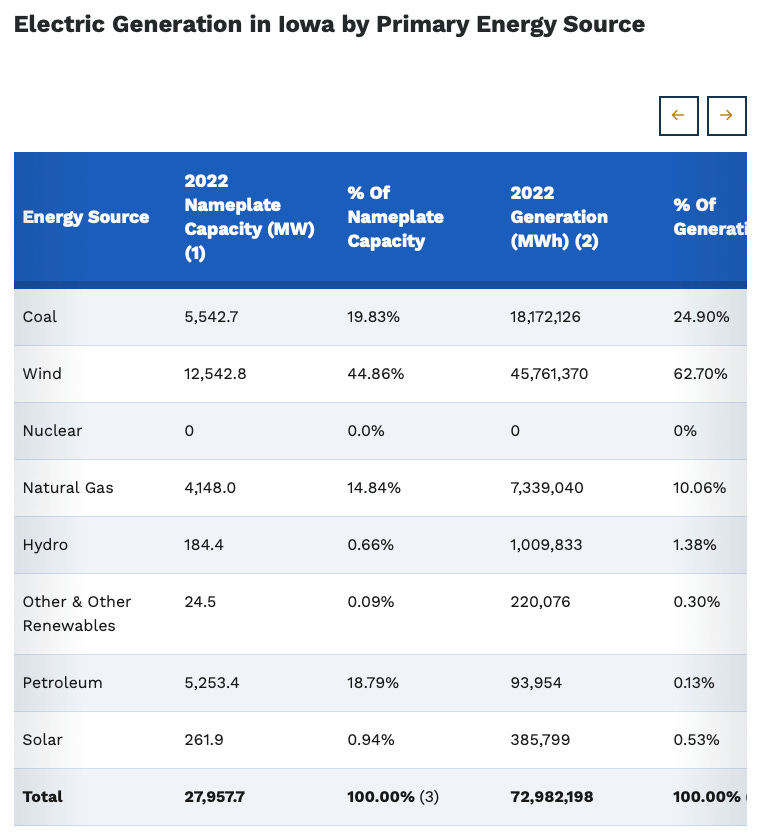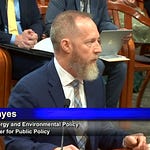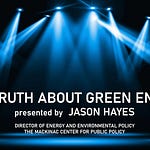
I hope everyone had a Merry Christmas / Happy Holidays and is looking forward to a productive and impactful 2025. I also hope you stayed warm and comfortable throughout the holiday period. As we count our many blessings, we should remember to say a special note of thanks for the safe, affordable, and reliable energy that powers our nation. On that note, before we sign off for the year, I wanted to post one more discussion on energy and decarbonization for your consideration.
On December 10, I joined Northwood University’s Dr. Timothy G. Nash and Yale Climate Connections’ Peter Sinclair on the Delta PBS show, The Follow Up, with host Michael Redford for a lively televised debate. We went back and forth on the issue in a show format that was too short to discuss a topic like this in any real depth. But all three of us did have an opportunity to dig into the issue.
Unsurprisingly, in his attempts to defend wind and solar and to claim a need for rapid decarbonization, Peter repeatedly misrepresented basic facts. For example, he offered up fantastical claims that people can’t fish in the Great Lakes because of mercury contamination from coal plants. However, the Great Lakes Fisheries Commission reports,
The Great Lakes commercial, recreational, and tribal fisheries are collectively valued at more than $7 billion annually and support more than 75,000 jobs. Lake whitefish, walleye, yellow perch, and ciscoes are the foundation of the commercial fishery while salmon, walleye, trout, and muskellunge (among many other species) help comprise the world-class recreational fishery. To support the millions of anglers that come to the lakes from around the globe, and to rehabilitate stressed fisheries, agencies stock fish in the Great Lakes each year. A healthy, vibrant Great Lakes fishery is good for the economy and the environment.
Peter also tried to claim that
Iowa is getting, between 70 and 80%, of its electricity from … primarily wind … there’s some solar coming in.
However, the Iowa Utilities Commission explains that in 2022, Iowa got about 63% of its electricity from wind and solar. So the numbers Peter cited as a defense of wind and its ostensibly low costs were 7% to 17% too high.
In the after-show, Peter also claimed that only 1% of the solar used in the United States is sourced in China. However, you have to work hard on your statistics to ignore that imports of solar panels and components from the other nations Peter cites—Indonesia and Malaysia—are often sourced in China first or produced by Chinese-owned firms in those countries. The Institute for Energy Research explains.
Construction of U.S. solar-manufacturing plants by Chinese companies is surging, putting China in position to dominate the industry, as other American factories struggle to compete despite federal subsidies. Chinese companies will have at least 20 gigawatts’ worth of annual solar panel production capacity on U.S. soil within the next year, enough to serve about half the U.S. market. The group includes seven companies backed by Chinese firms including Jinko Solar, Trina Solar, JA Solar, Longi, Hounen, Runergy, and Boviet. Chinese-backed companies have advantages over U.S. competitors due to heavily subsidized supply chains for raw polysilicon and unfinished solar modules and low-cost government financing. They also collect U.S. subsidies for “clean” energy manufacturing embedded in the 2022 Democrat-passed Inflation Reduction Act (IRA).
The Congressional Research Service has also explained this situation in detail.
The solar CS PV value chain comprises four primary stages of manufacturing, encompassing production of polysilicon, PV wafers, PV cells, and assembled panels. The majority of components needed for the panels that convert solar energy into electricity are sourced from outside the United States. For each major stage of CS PV manufacturing, Chinese companies operating throughout Asia own the majority of global production capacity. Production in the United States has declined due to import competition from Chinese manufacturers benefitting from various factors, including government support and economies of scale.
Domestic output in the first stage of the CS PV supply chain, the production of solar-grade polysilicon, declined by 40% between 2015 and 2018. This decline is largely attributed to antidumping and countervailing duties imposed by China on solar-grade polysilicon imports from the United States and several other countries since 2014. Nearly two-thirds of polysilicon production in China in 2020 came from plants in the Xinjiang region, where allegations of human rights abuses led the United States to place import restrictions in 2021."
[…]
"The majority of components needed for the panels that convert solar energy into electricity are sourced from outside the United States. For each major stage of CS PV manufacturing, Chinese companies operating throughout Asia own the majority of global production capacity. Production in the United States has declined due to import competition from Chinese manufacturers benefitting from various factors, including government support and economies of scale.”
[…]
"While PV panel assembly in the United States has increased since 2018 in the wake of increased U.S. import duties, many of the inputs into those panels are imported. A relatively small proportion of solar products sold in the United States is produced domestically.
Peter argued that the U.S. imports solar panels and components from countries like Indonesia and Malaysia rather than China. However, a December ’21 report from the U.S. International Trade Commission indicates that other shippers of solar cells and solar components into the U.S. sourced at least some portion of their product from companies that have had part of their imported products held at ports due to a national “withhold release order” imposed during the Biden Administration. The WRO was put in place by U.S. Customs and Border Protection because the Chinese components used in their products were produced by slave labor.
Peter’s willingness to ignore or brush over these basic facts indicates (at best) sloppy or careless research.
In “Grading the Grid,” Dr. Nash and I discussed the unfair business practices used by Chinese businesses and the Chinese government to help them control the world solar market.
The U.S. Department of Labor reports that “95% of solar panels worldwide are made up of polysilicon. Nearly half of global production comes from Xinjiang, where polysilicon is produced by Uyghurs and other Muslim minorities under conditions of forced labor.” The situation is so bad, according to the Department of Labor, that “China's system of forced labor threatens solar supply chains around the world.”
In a further ironic twist, Chinese polysilicon production is powered largely by cheap and reliable coal-fueled electricity. So, after they are installed in North America, Chinese solar panels may not produce carbon dioxide, but their manufacturers can’t make that same claim. “Coal, the dirtiest fossil fuel,” reports Time Magazine, “accounts for a majority of China's electricity generation. In Xinjiang Uyghur Autonomous Region, where the most energy-intensive step in the solar panel manufacturing process, polysilicon refining, is concentrated, coal accounts for 77% of power generation.” So, not only do a significant portion of Chinese solar panels have the stain of slavery, but they are also 30% more carbon-intensive than solar panels manufactured in the U.S. Put “into simple terms, Chinese solar products have much lower prices due to the use of slavery, subsidies, IP theft, and lax environmental regulations. No serious review of these conditions can claim this either a moral or competitive option.”
Lastly, while claiming that our research was somehow deficient, Peter openly admitted (at the 18:20 mark) that, in Grading the Grid, Dr. Nash and I properly and fairly explained the energy shortages in Texas during the February 2021 storm, Winter Storm Uri, in Texas.
But, important for that particular event. What you didn’t say, but what you did say, to your credit, you did say in your paper, you quoted the definitive study on that that came out of the University of Texas.
While Peter goes on attempting to paint the energy shortages experienced in Texas during Winter Storm Uri as a natural gas, coal, and nuclear problem, he brushes over the significant role wind played in the blackouts that plagued the state. To steal a line from Peter, I was also “watching these events in real time,” and I discussed them in a piece I wrote for USA Today immediately after the event.
The immediate cause for the power outages in Texas this week was extreme cold and insufficient winterization of the state’s energy systems. But there’s still no escaping the fact that, for years, Texas regulators have favored the construction of heavily subsidized renewable energy sources over more reliable electricity generation. These policies have pushed the state away from nuclear and coal and now millions in Texas and the Great Plains states are learning just how badly exposed they are when extreme weather hits.
Renewable’s defenders retort that Texas’ wind resource is “reliably unreliable.” Translation: It can’t be counted on when it’s needed most. The state has spent tens of billions of dollars on wind turbines that don’t work when millions of people desperately need electricity. As the cold weather has gotten worse, half the state’s wind generation has sat frozen and immobile. Where wind provided 42% of the state’s electricity on Feb. 7, it fell to 8% on Feb.11.
Unsurprisingly, the failure of wind has sparked a competing narrative that fossil fuel plants were the real cause of power outages. This claim can be quickly dispelled with a look at data from ERCOT, the state’s electricity regulator. Even though the extreme cold had frozen cooling systems on coal plants and natural gas pipelines, the state’s coal plants still upped their output by 47% in response to increasing demand. Natural gas plants across the state increased their output by an amazing 450%. Fossil fuels have done yeoman’s work to make up for wind’s reliable unreliability.
The more we discuss the issue of “Decarbonization or Dependability?,” the more we learn that the best defenses for the decarbonization side aren’t holding up. As I explain in the video,
We are rushing the decarbonization push. We're moving, like Tim said, faster than the technology is able to do the work. And so what's happening is it's destabilizing our grid and potentially putting people in a dangerous situation.
When it's -20° in Michigan and the snow's falling and it's cloudy and there's no wind blowing, we need something to provide reliable electricity.
…We need, as a nation and as a society, to have reliable and affordable electricity, if you don't have it it becomes dangerous.
I hope you enjoy the video and the debate. Feel free to chime in. Leave a comment. Where could we have done a better job explaining our work? What topics did we miss? What are your views on decarbonization vs. dependability?
Once you’re finished, feel free to share the post around.
Happy New Year!












